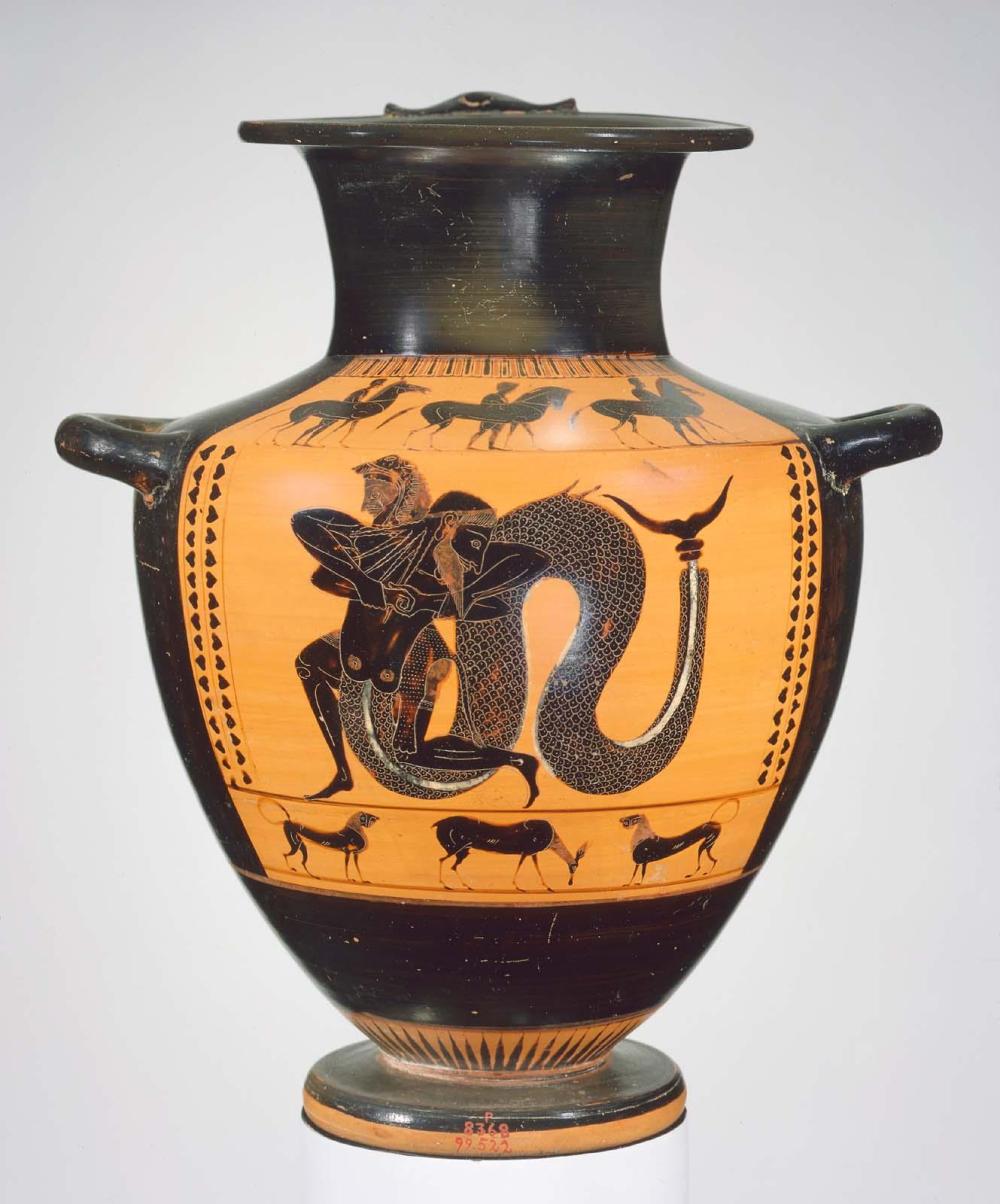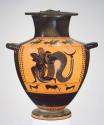Advanced Search
Water jar (hydria) depicting Herakles and Triton
Greek
Late Archaic Period
about 530–520 B.C.
Place of Manufacture: Greece, Attica, Athens
Medium/Technique
Ceramic, Black Figure
Dimensions
Height: 39.6 cm (15 9/16 in.); diameter: 29.2 cm (11 1/2 in.)
Credit Line
Henry Lillie Pierce Fund
Accession Number99.522
NOT ON VIEW
CollectionsAncient Greece and Rome
ClassificationsVessels
Although Herakles fought many monsters, there is no extant literary account of an encounter between the Greek hero and Triton, a minor sea deity. This mythical battle, popular throughout the sixth century in Athenian vase painting, appears to be an exclusively visual variant of the conflict between Herakles and Nereus, the Old Man of the Sea. In one of his labors, the hero wrestled with Nereus to learn the location of the golden apples of the Hesperides. During the fight, Nereus metamorphosed into several different forms-including water-before succumbing. Starting around 590 B.C., scenes featuring Herakles fighting either Nereus or Triton appear on vases; but by the middle of the century, the younger Triton is almost exclusively the opponent, sometimes with Nereus standing by as a spectator. Although some scholars see Athenian maritime dominance or the transition from tyranny to democracy as major factors in this shift to Triton, the difficulty of representing the metamorphosis of Nereus and the visual popularity of monsters may be the dominant factors in this change.
Here Triton has the upper torso and head of a man but sports a long, fishlike tail that undulates across the picture plane like a wave. Herakles wears his customary lion headdress, and the juxtaposition of the two figures underscores the ancient Greek fascination with composite creatures. The black-figure vase-painting technique, with its emphasis on the ornamental pattern so pervasive in Archaic art, was well suited to this subject matter, which appears on only a few red-figure vases. The overlap of the shapes of the bodies and intricate incision of the scales make this vessel an outstanding example of sixth-century-B.C. art. Matching subject matter to function, the sea creature on the outside of this vessel used for fetching and pouring water serves as a visual reference to its liquid contents.
Here Triton has the upper torso and head of a man but sports a long, fishlike tail that undulates across the picture plane like a wave. Herakles wears his customary lion headdress, and the juxtaposition of the two figures underscores the ancient Greek fascination with composite creatures. The black-figure vase-painting technique, with its emphasis on the ornamental pattern so pervasive in Archaic art, was well suited to this subject matter, which appears on only a few red-figure vases. The overlap of the shapes of the bodies and intricate incision of the scales make this vessel an outstanding example of sixth-century-B.C. art. Matching subject matter to function, the sea creature on the outside of this vessel used for fetching and pouring water serves as a visual reference to its liquid contents.
Catalogue Raisonné
CVA Boston 2, pl. 076; Highlights: Classical Art (MFA), p. 161.
DescriptionPanel on front and shoulder. On body, Herakles and Triton. On shoulder, three youths, each leading a horse to right.
ProvenanceBy date unknown: according to CVA, Boston, fasc. 2, pl. 76: from Vulci; by date unknown: Campanari Collection; by 1856: Rogers Collection; 1856: with Christie and Manson (sale of the Rogers Collection, lot 347); by 1899: Collection of W. H. Forman; 1899: with Sotheby, Wilkinson & Hodge, 13 Wellington Strand, London, W.C. (sale of the Forman Collection, June 19-22, lot 284); 1899: with Edward Perry Warren (according to Warren's records: From Campanari and Rogers Collections. Forman Sale, Lot 284); purchased by MFA from Edward Perry Warren, 1899, for $ 32,500.00 (this is the total price for MFA 99.338-99.542)



